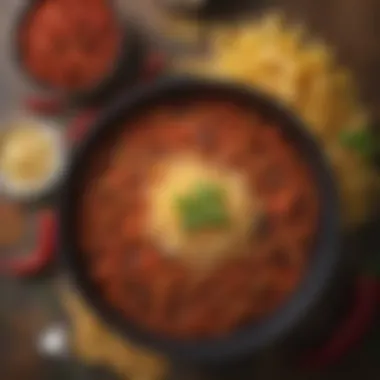Exploring Pasta in Chili: A Unique Culinary Fusion


Intro
The fusion of pasta and chili is an intriguing culinary concept that integrates two beloved dishes into one unique creation. This article seeks to explore this innovative combination, detailing its historical context and the sensory experience that comes from the meeting of these diverse flavor profiles. By understanding the essence of this fusion dish, we can appreciate how it manages to provide both comfort and a contemporary twist to traditional cooking.
Recipe Overview
Name: Chili-Pasta Delight
Portions: 4 servings
Time Required: 30 minutes for preparation and cooking
Difficulty: Easy
Main Ingredients:
- Fusilli pasta
- Ground beef or turkey
- Kidney beans
- Tomato sauce
- Chili powder
- Garlic and onion
Step-by-Step Instructions
Ingredient Preparation
- Cook the Pasta: Begin by boiling salted water in a large pot. Cook the fusilli pasta according to package instructions. Drain and set aside.
- Sauté Aromatics: In a large skillet, heat some olive oil over medium heat. Add diced onion and minced garlic, stirring until the onion becomes translucent.
- Brown the Meat: Add the ground beef or turkey to the skillet. Cook until browned and thoroughly cooked. Drain any excess fat.
- Combine Ingredients: Stir in the tomato sauce, kidney beans, and chili powder. Allow this mixture to simmer for about ten minutes to meld the flavors.
- Pasta Integration: Finally, fold in the cooked fusilli pasta with the chili mixture. Mix until the pasta is evenly coated with sauce.
Time-Saving Strategies
- Use Canned Items: Opt for canned beans and premade tomato sauce for quicker preparation.
- Pre-Cooked Pasta: Consider using precooked pasta, available in some grocery stores, to save time.
- One-Pot Method: If preferred, use a single pot for cooking pasta and sauce simultaneously. Add pasta just when the chili simmers.
Nutritional Information
- Total Calories: Approximately 450 calories per serving
- Protein: 25g
- Fats: 15g
- Carbohydrates: 55g
Beneficial Nutrients
- Fiber: From beans and pasta
- Iron: From ground beef or turkey
- Vitamins: B vitamins from the pasta and vegetables
Quick Cooking Tips
- Utilize Kitchen Gadgets: Use an instant pot for faster cooking. The pressure cooker can reduce overall cooking time significantly.
- Multitasking: While your pasta is boiling, start browning your meat. This cuts down on waiting time.
- Healthier Options: Replace ground meat with lentils or textured vegetable protein for a vegetarian version.
Related Recipes & Variations
- Macaroni Chili Bake: A bake version using macaroni and adding cheese.
- Spicy Sausage Chili Pasta: Incorporating spicy sausage for a kick.
- Vegan Chili-Pasta: Substitute meat with plant-based proteins and use vegetable broth.
This unique culinary fusion presents a tantalizing way to elevate two simpler dishes into something noteworthy and satisfying.
Foreword to Pasta in Chili
The fusion of pasta and chili is a culinary concept that can broaden the spectrum of flavors and textures in familiar dishes. This section aims to explore the significance of embracing such a blend in contemporary cooking. With the integration of two staple cuisines—Italian and American Southwestern—cooks can create meals that are both hearty and innovative, with the potential to cater to various dietary preferences and lifestyles.
The Concept of Culinary Fusion
Culinary fusion is the art of combining two or more cooking traditions to create dishes that are both unique and flavorful. By merging pasta with chili, cooks can leverage the rich, comforting texture of pasta while infusing it with the robust flavors and spices typical of chili dishes. This creation is not merely about mixing ingredients; it involves understanding the delicate balance between different flavor profiles.
For example, while pasta may bring a mildness and texture, chili contributes heat and depth. This union offers an opportunity to experiment, adapting recipes based on personal tastes and dietary restrictions. Moreover, it encourages creativity in the kitchen, allowing chefs to develop dishes that resonate with diverse palates.
Historical Background
The evolution of pasta in chili has deep roots involving cultural exchanges. Pasta, originating from Italy, has been a staple for centuries. Meanwhile, chili, particularly in the form we know it today, has strong ties to Native American, Spanish, and Mexican cuisines. The blending of these two traditions can be traced back through periods of migration and culinary experimentation.
As globalization increased, culinary influences began to overlap. In regions like the southwestern United States, the introduction of pasta into traditional chili recipes signifies a shift in culinary practices. During this interaction, cooks started substituting pasta for traditional accompaniments like rice or bread, leading to comforting and filling dishes that reflect both heritage and innovation.
This historical context provides a foundation for understanding the ongoing appeal of this fusion. By examining how and why these culinary practices came together, one can appreciate the depth behind each dish created, making every bowl of pasta in chili a celebration of history and flavor.
Flavor Profiles: Pasta and Chili
The fusion of pasta and chili is far more than just a combination of foods. It represents a harmonious blend of flavors, textures, and culinary traditions that can cater to diverse palates. Understanding the flavor profiles in this context is essential for achieving a dish that delights the senses. It enables culinary enthusiasts to craft recipes that balance various elements while retaining the essence of both pasta and chili.
Understanding the Core Ingredients
At the heart of any dish lies its core ingredients. In the case of pasta in chili, the primary components include pasta, chili, and a selection of vegetables and spices.
- Pasta offers a neutral base that absorbs flavors and provides texture. Options such as penne, fusilli, or even spaghetti can add different dimensions to the dish.
- Chili can vary significantly, whether it is a traditional meat chili or a vegetarian bean chili. Each type brings unique flavor notes, ranging from spicy and savory to earthy and sweet concoctions.
- Vegetables like bell peppers, corn, and onions enhance the dish, making it not only more colorful but also nutritionally richer.
- Spices such as cumin, paprika, and chili powder are crucial in elevating the overall taste. They define the character of the chili and can either brighten or deepen the flavors already present.
The combination of these core ingredients creates a foundation for a complex flavor profile that respects both culinary worlds.
Balancing Spices and Acidity


Balancing spices and acidity is a vital part of achieving a successful pasta and chili fusion. Each element contributes to the overall taste in distinct ways.
Spices imbue the dish with warmth and depth. However, without a counterbalance, they may overpower the subtler flavors of the pasta. This is where acidity comes into play. Ingredients like lime juice, diced tomatoes, or even a splash of vinegar help to cut through the richness, providing a refreshing contrast.
When balancing these elements, consider:
- Assessing the spice levels: Start with a base amount and gradually add more, tasting along the way.
- Incorporating acidic ingredients: Add these toward the end of cooking to ensure they maintain their brightness in the dish.
- Testing for flavor harmony: Occasionally, an additional pinch of sugar can help round out flavors if the dish feels too bitter or spicy.
"The real art of cooking lies in the balance of flavors. Keep tasting as you go to ensure your dish reaches its maximum potential."
Preparation Techniques
Preparation techniques play a vital role in crafting an appealing dish that combines pasta and chili. The methodology behind making this fusion dish can greatly enhance the flavor and texture, ultimately impacting the dining experience. Choosing the right preparation method can save time while also ensuring that the dish remains nutritious and enjoyable. This section will focus on how specific elements within the preparation phase contribute to the overall effectiveness of integrating pasta within chili dishes.
Selecting the Right Pasta
Pasta selection is crucial when preparing chili, as different shapes and textures interact uniquely with the sauce and spices. Consider the characteristics of pasta, such as thickness and surface area. For instance, a chunky chili pairs well with fatter varieties like penne or rigatoni, which pick up the sauce effectively. Meanwhile, a more delicate sauce might benefit from thinner pasta types like angel hair.
It is also important to consider the cooking time of the pasta. Some pastas require longer cooking times than others. This can influence how the dish comes together. To achieve a harmonious flavor profile, choose a pasta that complements the chili’s cooking time, ensuring both components are ready simultaneously for optimal texture and taste.
Cooking Methodology
The cooking methodology can vary greatly depending on personal preferences and available kitchen tools. Each method has its own merits, making them suitable for different situations. Here, we will explore three common techniques: stovetop, slow cooker, and Instant Pot.
Stovetop Methods
Stovetop cooking is a traditional method that many home cooks favor. The process allows for real-time adjustments. By using this method, you can carefully monitor the consistency of the chili and ensure that the pasta remains al dente.
One key characteristic is the ability to layer flavors. Cooking pasta separately and then adding it to the chili at the end allows for a more controlled texture. The disadvantages include potentially increased cleanup since multiple pans are typically used. However, if you enjoy the engagement of layering flavors, this method is beneficial.
Slow Cooker Utilization
Slow cooking offers a set-it-and-forget-it approach. Combining pasta and chili in a slow cooker means the flavors meld beautifully as they simmer over time. This technique is ideal for those who have busy schedules.
The main advantage is the convenience that comes with minimal hands-on time. Even though cooking pasta separately is usually recommended, adding it toward the end can work with some recipes. The unique feature here is culinary flexibility, giving you the freedom to mix various ingredients without worrying about constant supervision. The downside is that some might feel the pasta may become softer compared to stovetop methods.
Instant Pot Advantages
The Instant Pot is a modern solution that combines multiple cooking techniques into one appliance. This method provides quick cooking times while retaining the depth of flavor that slow-cooked dishes typically offer. The pressure cooking technique ensures the pasta absorbs the chili flavors effectively.
A key characteristic of the Instant Pot is its speed. A dish that may take hours to develop flavors can often be completed in under an hour. The use of an Instant Pot can be particularly beneficial for busy individuals looking to streamline meal preparation. However, the disadvantage is that overcooking can occur quickly due to the high-pressure environment, which requires careful timing.
Achieving Optimal Texture
Achieving the right texture between pasta and chili is fundamental to the overall dish. The proper cooking of both components ensures that neither is overdone nor undercooked. Factors like pasta shape, cooking method, and even the sequence in which ingredients are added can collectively influence the final texture. Monitoring these details closely allows for a cohesive blend, resulting in a satisfying culinary experience.
Variations of Pasta in Chili
The discussion of variations of pasta in chili is essential for understanding how this fusion dish can cater to diverse preferences and dietary needs. Each variation brings its unique twist on flavor and texture while also expanding the dish’s appeal to a broader audience. Considering various options not only enhances the dining experience but also encourages creativity in the kitchen. By exploring these adaptations, one can find the right fit for any occasion, whether hosting a gathering, preparing a weeknight meal, or looking to satisfy specific dietary restrictions.
Vegetarian Options
Creating a vegetarian pasta chili opens up a world of possibilities. By omitting meat, the dish can become a celebration of vegetables and legumes. Important ingredients like black beans, kidney beans, and lentils serve as excellent protein substitutes. Vegetables such as bell peppers, zucchini, and corn add both nutrition and color. Additionally, spices like cumin, oregano, and chili powder can enhance the depth of flavor without relying on animal products.
When preparing vegetarian options, consider the following:
- Use quality pasta. Opting for whole grain or legume-based pasta not only increases fiber content but also improves the overall nutritional profile.
- Focus on umami. Incorporate ingredients like mushrooms or nutritional yeast to impart a savory taste.
- Layer flavors. Start by sautéing aromatics like onions and garlic before adding the other ingredients to deepen the flavor.
These components make vegetarian pasta chili a wholesome and satisfying alternative.
Meat-Based Variants
For those who enjoy meat, incorporating protein into pasta chili can elevate its savory profile. Ground beef, turkey, or chicken can provide heartiness to the dish. When selecting meat, consider using lean meats to maintain a balance of flavor and nutrition.
Here are some key considerations for meat-based variants:
- Browning the meat. Properly browning the meat before adding the chili components creates depth, enhancing the overall flavor.
- Taste the balance. The richness of the meat should be balanced with acidity from tomatoes or citrus to prevent overwhelming the palate.
- Customize the type of meat. Different meats can create distinct flavor profiles; for example, chorizo adds a spicy kick, while bacon imparts smokiness.
By taking these elements into account, meat-based pasta chili can become a satisfying and flavorful dish that appeals to meat lovers.


Gluten-Free Alternatives
For individuals with gluten intolerance, gluten-free pasta options allow for enjoyment of this dish without compromising dietary restrictions. Many brands offer alternatives made from quinoa, brown rice, or chickpeas, providing similar textures to traditional pasta.
Here are some tips for using gluten-free products in pasta chili:
- Cook carefully. Gluten-free pasta can become mushy if overcooked, so follow package instructions closely.
- Consider additional thickeners. If the chili seems runny, gluten-free flour or cornstarch can be used to thicken it without gluten.
- Explore flavor enhancements. Herbs and spices can provide additional layers of flavor that are sometimes considered missed in gluten-free options.
Incorporating gluten-free pasta allows a more inclusive approach, ensuring that everyone can partake in the culinary experience.
"Variations in pasta chili not only highlight the adaptability of the dish but also its ability to cater to individual tastes and preferences."
By recognizing and implementing these variations, one can enhance the enjoyment of pasta chili while respecting diverse dietary needs. This adaptability is a cornerstone of why this fusion dish has gained popularity across different culinary cultures.
Nutritional Considerations
The nutritional value of any dish affects not only the health of individuals but also their overall culinary experience. When combining pasta and chili, several factors must be taken into account. Understanding the balance of nutrients is essential for achieving a satisfying and wholesome meal. This section explores macronutrient breakdown and the significance of integrating more vegetables into your pasta chili recipe.
Macronutrient Breakdown
Macronutrients—carbohydrates, proteins, and fats—are crucial in every diet. Pasta primarily provides carbohydrates, which serve as a source of energy. Chili can be a rich source of proteins and fats, depending on the ingredients you choose.
- Carbohydrates:
- Proteins:
- Fats:
- Pasta contributes a significant amount of carbohydrates to the meal. Whole grain or legume-based pasta can enhance fiber content, promoting better digestion.
- Including beans, lentils, or lean meats in your chili will elevate the protein levels. For vegetarians, chickpeas or tofu can equally fulfill this requirement.
- The fat content varies based on cooking methods and added oils. Lean meats and healthy oils like olive oil can offer good fats without excessive calories.
A balanced meal considers all these macronutrients. The goal should be to combine them effectively, allowing for a fulfilling and nutritious experience without overloading on any single nutrient type.
Incorporating Vegetables
Vegetables are pivotal when considering the nutritional aspects of any dish. They not only enhance the flavor and texture but also provide essential vitamins, minerals, and fiber. In a pasta chili context, here are some vegetables that can be used:
- Bell Peppers: Colorful and rich in vitamins A and C, diced bell peppers can add sweetness and crunch.
- Onions: A base flavor that benefits from sautéing, enriching the entire dish with minerals like potassium.
- Tomatoes: Fresh, diced tomatoes or tomato sauce can contribute to acidity and a juicy texture while delivering vitamins and antioxidants.
- Zucchini: Adding zucchini can increase your fiber intake and promotes a low-calorie count, making it especially valuable for weight management.
Incorporating a variety of vegetables can also encourage a broader range of nutrients and can make the meal visually appealing. This diversity enhances both the health benefits and the overall eating experience, making pasta chili not just flavorful, but also a nutritious choice. Incorporation of leafy greens like spinach or kale can further round out the dish, delivering even more richly colored nutrients.
"Eating a mixed plate of colorful vegetables provides essential nutrients typically missing from a diet dominated by processed foods."
Understanding these nutritional considerations leads to better meal planning and culinary experimentation, harmonizing the delightful flavors of pasta and chili.
Serving Suggestions
The section on serving suggestions plays a crucial role in enhancing the overall dining experience of pasta in chili. Effective serving ideas can elevate the dish, providing not only delightful taste but also appealing presentation. Proper garnishes, toppings, and side pairings help to create balance and harmony on the plate. When serving pasta in chili, consider these elements that can make a significant difference in flavor and enjoyment.
Garnishes and Toppings
Garnishes and toppings are vital in enriching the visual and flavor profile of pasta in chili. They not only add a pop of color but also introduce new textures and tastes. Common garnishes include freshly chopped cilantro, basil, or parsley, which impart freshness and aroma. Grated cheese, like cheddar or Parmesan, offers a creamy texture that contrasts nicely with the spicy chili.
Some other popular toppings are:
- Sour cream or Greek yogurt: These add a cooling element that balances the heat of the chili.
- Avocado slices: Creamy and rich, enhancing the overall mouthfeel.
- Crushed tortilla chips: These provide crunch, adding a different layer of texture.
Experimenting with these garnishes can lead to a more complex and satisfying dish. The addition of toppings should complement the chili’s spice without overpowering its core flavors. The key is to ensure a thoughtful layering of tastes and textures for an elevated dining experience.
Pairing with Sides
Side dishes can significantly enhance the meal when serving pasta in chili. They can provide contrast and additional flavor, completing the overall experience. Consider options that resonate harmoniously with the chili's flavors while providing variety on the plate.
Suitable side options include:
- Garlic bread: A classic choice, offering a nice crunchy texture and flavor that complements the dish.
- Steamed vegetables: A light option to add nutrition and color, choose vegetables like broccoli or bell peppers.
- Simple green salad: This can brighten the meal and provide a refreshing palate cleanser between bites.
Choosing the right sides is all about balance. Sides should enhance the experience without dominant flavors that clash with the primary dish. By thoughtfully combining pasta in chili with appropriate sides, one can create an impressive, multifaceted meal.
Serving Suggestions are essential in boosting both the aesthetic appeal and overall enjoyment of the meal. A good garnish can transform a dish from plain to extraordinary, while thoughtful side dishes round out the experience.


Practical Tips for Quick Preparation
Pasta in chili marries two delightful cuisines, and understanding practical preparation tips can significantly enhance the experience. Quick preparation is essential for modern cooks who often balance numerous tasks. By utilizing effective strategies, one can minimize cooking time without sacrificing flavor or nutrition.
Time-Saving Strategies
Prepping Ingredients Ahead
Prepping ingredients ahead is a crucial step that allows for smoother cooking sessions, especially in busy households. This practice involves chopping vegetables, measuring spices, and cooking pasta in advance. When ingredients are ready before cooking commences, it allows the cook to focus on the overall execution of the dish. A primary characteristic of this approach is its emphasis on organization, which is valuable for maintaining a stress-free kitchen environment.
Additionally, by prepping ingredients ahead, one can control the freshness in each dish. It's common to prepare a larger batch of chili and store it for later use. This not only saves time but also enhances flavor, as allowing the dish to rest can develop deeper taste profiles.
While prepping does require initial time investment, the long-term benefits outweigh the short-term effort. However, storage is a consideration; it’s important to ensure that ingredients are kept properly to maintain integrity and avoid spoilage.
Using Leftovers Wisely
Utilizing leftovers efficiently is another vital component of quick preparation. Leftover chili or pasta can be transformed into new meals. For instance, leftover chili can be repurposed as a topping for baked potatoes, while leftover pasta can be mixed into a salad or cooked into a soup. This strategy not only reduces food waste but also turns previous meals into new culinary experiences.
The key characteristic here is creativity; interpreting leftovers in diverse ways adds fun to cooking. Using leftovers wisely saves both time and resources, making it a popular choice among home cooks. However, different types of leftovers have varying shelf lives and quality that may affect how they can be reused. Being mindful of these characteristics is essential for achieving the best possible outcome from every ingredient.
Simplifying Cleanup
Simplifying the cleanup process is an essential but often overlooked aspect of cooking. Utilizing fewer pots and pans not only helps save time during meal prep but also makes the task of cleaning up less daunting. For example, using a single pot for boiling pasta and cooking chili simultaneously can minimize dishwashing.
Another useful tip is to line pots and pans with foil or parchment paper. This small step reduces the mess from sauce or cheese sticking to surfaces, making post-cooking cleanup much easier. Keeping cleaning supplies well organized and within reach can also aid in shortening the cleanup time.
Incorporating these practical tips into your cooking routine may significantly enhance the preparation process. By focusing on efficiency and creativity, culinary enthusiasts can enjoy preparing pasta in chili while maintaining a well-organized kitchen.
Exploring Culinary Cultures
The fusion of pasta and chili is not just a delightful combination of flavors; it also serves as a reflection of the diverse cultural landscapes where these two iconic dishes originate. Understanding the culinary cultures surrounding these foods can enrich the experience of cooking and enjoying them. This section explores regional adaptations and global influences that shape how pasta is prepared and consumed in relation to chili. By examining these elements, readers will gain insights into the wider context of this unique dish.
Regional Adaptations
When considering pasta in chili, different regions bring their own twist to this dish. These adaptations often stem from local ingredients, cooking styles, and cultural preferences.
In the United States, for instance, chili is typically hearty, with a focus on beans, ground meats, and spices. When pasta is incorporated, it tends to dominate the dish's texture. Varieties such as macaroni or egg noodles are common. In this way, the dish becomes a casserole, and often cheese is added for richness.
In Italian regions, however, the origin of pasta, the incorporation may reflect a lighter approach. Fast-cooking spaghetti often gets paired with a tomato-based chili sauce that adds flavor without overwhelming the pasta.
Some examples of regional adaptations include:
- Chili Mac: A popular dish in Midwestern states, combining elbow macaroni with chili and topped with cheese.
- Pasta e Fagioli: An Italian bean stew that sometimes features a hint of chili flavor, providing a parallel to traditional chili.
These regional adaptations not only highlight local preferences but also showcase how pasta and chili can work in harmony, leading to new culinary experiences.
Global Influences
The interplay between global cuisines significantly influences how pasta and chili are combined. This fusion is evident in various international dishes that reinterpret both pasta and chili. Exploring global influences highlights culinary creativity—a hallmark of culinary fusion.
In Latin America, for instance, pasta dishes may be enriched with local peppers or spices, leading to a unique twist on the traditional chili. By incorporating ingredients like jalapeños or chipotle, one can create a rich chili that embodies flavors native to the region. Similarly, in Asian cuisines, rice noodles may serve as the base instead of traditional pasta, offering a different texture and taste.
Notable global influences include:
- Chili con Carne: In certain cultures, this dish may be served over rice noodles instead of spaghetti, providing a fresh perspective on flavor and texture.
- Thai Chili Pasta: Mixing spaghetti with Thai chili flavors, introducing sweet and sour elements that contrast traditional chili offerings.
"The beauty of culinary fusion lies in its ability to evolve, mixing traditional and modern approaches to create something unique."
By understanding regional adaptations and global influences, chefs and home cooks alike can experiment with pasta in chili, paving the way for innovative recipes. These explorations foster appreciation, unlocking possibilities for culinary creativity and cultural appreciation in the kitchen.
Ending
The conclusion of an article can often provide a summation, but it is more than just a wrap-up. In this case, the exploration of pasta in chili is a topic that carries significant weight, especially as culinary boundaries continue to shift. The fusion of these two seemingly distinct culinary traditions invites chefs and home cooks alike to broaden their horizons and play with ingredients in unprecedented ways.
Recap of Key Points
Throughout this article, we dived deeply into several aspects of the fusion of pasta and chili:
- Historical Context: Understanding the origins of both dishes helps in appreciating the creativity behind their combination.
- Flavor Profiles: The blend of spices, textures, and ingredients distinguishes this dish from standard recipes. Recognizing these profiles enables more informed decisions about preparation.
- Preparation Techniques: Knowing how to cook the pasta and chili separately or together can lead to optimal results, enhancing the eating experience.
- Variations: Whether vegetarian, meat-based, or gluten-free, the variety of options caters to diverse dietary needs, making this fusion accessible to a broader audience.
- Nutritional Considerations: Considering the nutritional values emphasizes that this dish can be both delicious and wholesome.
- Practical Tips: Incorporating time-saving methods and simplifying cleanup makes it a suitable option for those with busy lifestyles.
Encouragement to Experiment
As the culinary landscape becomes increasingly global, the push for innovation becomes paramount. Bringing pasta into chili is more than just a combination of two elements; it represents an opportunity to explore new culinary territories. Don't hesitate to try various ingredients or cooking methods. Replace traditional beans with chickpeas or add a twist by using ramen noodles instead of typical pasta.
Experimentation can lead to refreshing discoveries, adding personal flair to your dish. Remember, the best meals often arise from trial and error. Thus, not only will you be able to create your own unique version of pasta in chili, but you may also uncover new techniques and flavor profiles along the way.





